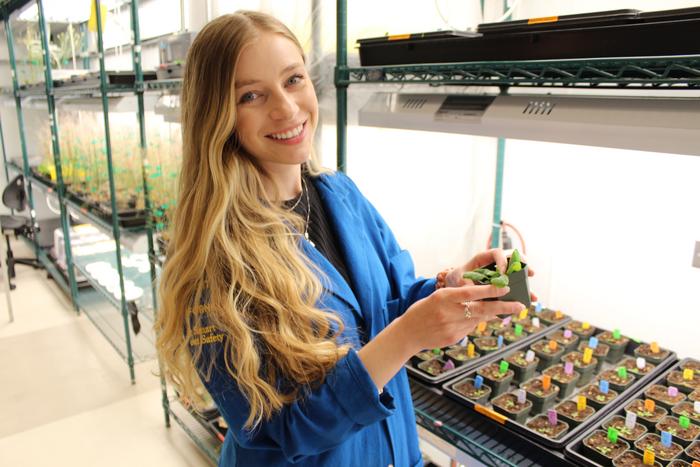
Parasitic weeds represent a significant threat to global agriculture, particularly in regions plagued by food shortages. These relentless intruders have evolved sophisticated methods to siphon off vital nutrients from crops like rice and sorghum, leading to widespread devastation of harvests. At the University of California, Riverside (UCR), researchers are endeavoring to reverse the tide against these invasive species, exploring an innovative approach that may not only aid farmers but also contribute to food security.
The backbone of this groundbreaking research hinges on the manipulation of plant hormones known as strigolactones. While plant hormones typically serve internal roles—regulating growth and responding to environmental stresses—strigolactones are unique. They operate both externally and internally, enabling plants to communicate with beneficial soil fungi to aid root development. Unfortunately, this signaling mechanism has been subverted by parasitic weeds, which utilize strigolactones as a beacon to locate and invade their host plants.
This unusual interaction has ignited a flurry of scientific inquiry aimed at understanding how strigolactones function. The standard response from parasitic weeds involves germination at the detection of these hormones, which enables them to attach to the roots of host plants indiscriminately. Farmers currently have limited options to counteract this existential threat. UCR’s research aims to exploit the very signals that parasites use against them, flipping the script to trigger their self-destruction.
The research team, led by Yanran Li and supported by renowned UCR botanist David Nelson, has developed a system employing genetically modified bacteria and yeast. This system simulates the biochemical processes necessary for strigolactone production, allowing researchers to explore its synthesis in a controlled environment. This methodology represents a significant leap forward, opening up possibilities for manufacturing large quantities of strigolactones while concurrently exploring the intricate biochemistry that governs their synthesis.
As the research progresses, the potential to refine strigolactone signaling becomes tantalizingly feasible. By carefully timing the application of these hormones, scientists can instigate premature germination in parasitic weeds, essentially orchestrating a scenario where these intruders sprout without a host to leech nutrients from. This strategy, referred to by Nelson as “encouraging them to commit suicide,” could fundamentally alter the landscape of agricultural practices targeted at managing weed populations.
In addition to addressing agricultural challenges, strigolactones exhibit promise beyond crop management. These compounds could play vital roles in medical and environmental sciences. Early studies suggest their potential as anti-cancer or anti-viral agents, signifying a multi-faceted avenue for exploration that transcends mere agricultural applications. Particularly notable is the interest in strigolactones concerning citrus greening disease — a formidable enemy to citrus crops in Florida.
The synergy between fundamental research and applied sciences is critical in addressing the rampant issue of food insecurity. This project exemplifies how innovative biological and engineering solutions can provide both immediate agricultural benefits and broader societal advantages. Julia Bailey-Serres, a distinguished professor at UCR and leader of the NSF-funded Plants3D traineeship program, emphasizes the significance of this initiative. It empowers students to harness advanced technologies in the pursuit of increasing crop yield and nutritional value, ultimately aiding the global fight against hunger.
The implications of successfully implementing a strigolactone-based weed control strategy could be transformative for farmers who have long battled parasitic weeds with suboptimal tools. By leveraging cutting-edge technologies to engineer plants and modify their signaling pathways, researchers are aiming to deliver solutions that are not only effective but sustainable.
Nevertheless, unanswered questions linger regarding the practicality of deploying these techniques on a broad scale. Researchers must validate their findings in real-world agricultural settings to ensure that the designed approach can hold up against the unpredictable climate and ecological variance encountered in global farming practices. To this end, fine-tuning the chemical signals is underway, with the hope that the research will yield strategies that significantly bolster agricultural resilience.
In this evolving landscape of agricultural innovation, the scientific community remains committed to unraveling the complexities of plant signaling. This research stands at the forefront of a potentially vital breakthrough in bioengineering, emphasizing the interconnectedness of plant biology and agricultural viability. As findings continue to emerge from UCR’s laboratories, one can only hope that such strategies will provide farmers with new, effective tools in their fight against persistent agricultural threats.
As food security remains a pressing issue, the implications of this research extend beyond the academic realm. It serves as a beacon of hope that collaborative efforts in science can yield impactful solutions to some of the world’s most pressing challenges. With researchers dedicated to transforming knowledge into actionable strategies, the fight against parasitic weeds may ignite new pathways towards sustainable agricultural practices.
In conclusion, the UCR research effort to leverage strigolactones against parasitic weeds not only showcases the power of scientific inquiry but also underscores the necessity of innovative solutions in securing our food systems. As this research progresses, it holds the promise of enhancing agricultural productivity while addressing environmental constraints, thereby contributing towards a sustainable future.
Subject of Research: Strigolactones in Parasitic Weed Management
Article Title: Evolution of Interorganismal Strigolactone Biosynthesis in Seed Plants
News Publication Date: 17-Jan-2025
Web References: http://dx.doi.org/10.1126/science.adp0779
References: DOI: 10.1126/science.adp0779
Image Credits: Credit: Claudia Sepulveda/UCR
Keywords: strigolactones, parasitic weeds, agriculture, food security, plant hormones, crop management, plant signaling, biotechnology, environmental applications, agricultural sustainability, plant biology, chemical synthesis.
Tags: agricultural research advancementscombating parasitic weedscrop protection techniquesecological impacts of parasitic plantsfood security through agricultureinnovative solutions for farmersinvasive species controlnutrient depletion in cropsparasitic plant management strategiesplant hormone manipulationstrigolactones in agriculturesustainable farming practices





